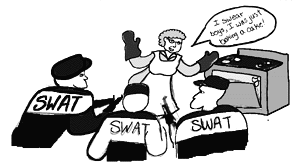|
High
technology is high spying Last week, the U.S. Supreme Court heard a rather peculiar case that seeks to define the use of high technology in crime fighting with regards to the individual’s right to privacy. The case centers on the arrest of Danny Lee Kyllo, who was apprehended in his apartment by Oregon police after an Oregon National Guardsman assisted local law enforcement officials by scanning his apartment with a thermal imaging device. According to U.S. Court of Appeals records, authorities in Oregon were investigating Kyllo’s possible involvement in “a suspected marijuana growing and distribution operation.” After examining subpoenaed utility records, authorities concluded the suspects usage was abnormally high, which led to use of the device. The thermal
imaging device, the Agema Thermovision 210, detected abnormal amounts
of heat emitting from Kyllo’s garage and roof. After careful
analysis, law enforcement agents determined the heat being discharged
was most likely coming from heat lamps used for the cultivation
of marijuana. This assumption proved correct when agents found more
than 100 marijuana plants and related drug paraphernalia in Kyllo’s
apartment. While it is readily apparent that Kyllo was breaking the law by possessing marijuana, the way law enforcement officials went about detecting this crime is absolutely unconstitutional. The Fourth Amendment specifically protects the individual “against unreasonable searches and seizures.” Government attorneys for the case argue that the police obeyed this amendment because the use of the device is really no different than having an officer simply observe the apartment. However, when the police utilized a device that heightened their natural perceptive abilities and saw clues from Kyllo’s apartment that were not readily evident to the naked eye, they plain and simply went above the law. While the thermal imaging device does not function like an x-ray per se, it allows an intrusion into homes that should not be permitted. On a normal basis, the heat emitting from your home should be considered above the realm of legal detection by law enforcement officials. For example, when you make a phone call on your cell phone inside your home and discuss illegal matters, you are knowingly (or at least you should be knowingly) sending out information from your home to another location. Therefore, it is legal for that information to be intercepted by law enforcement members with just cause and the right paperwork. In contrast, if you have heat lamps in your home for whatever reason, you should not have to be concerned with the heat that escapes your residence because of the lamps unless, of course, the heat is causing visible damage (i.e. fire). Besides, if police are using the presence of heat as means for acquiring a search warrant, doesn’t that open the door for abuses of the system? Back home, my family’s oven is installed right next to an exterior wall (as it is with most homes). Should the police be able to break down our door and search the house because they thermally detected large amounts of heat on the outside of the wall, which in truth would be caused by the oven being in use? The outcome of this particular court case will not solely affect the future use of thermal imaging devices for policing, but also detection technology in general. Currently, equipment even exists that allows one to listen to the inside of a building using a laser device simply pointed at a window. The laser reflects vibrations hitting the window, vibrations like those that come from the human voice, and allows the receiver to “hear” what is being said inside the room. Just like thermal imaging devices, this laser tool can allow for a clear infringement of privacy. The Supreme Court must set a precedent so the use of these types of equipment can be regulated before further misuse occurs. I am not saying the use of thermal imaging devices should not be used in police work. Currently, many local law enforcement agencies have been using night vision devices, which are similar to thermal imaging devices. The night vision devices are attached to patrol cars when police are trying to look for suspects in dark areas. This situation is different because these devices are used to “see” into open, public spaces. What you do out in a public area is the public’s business, and thereby can be legally investigated by the police. On the other hand, you should expect a certain level of privacy when you are inside your home. People should be able to do whatever they wish in their privacy of their own homes, as long as he or she does not harm others in the process. If we allow law enforcement spy into our homes, we will digress to a state that only the likes of George Orwell could have pictured. Robert
Davis is a senior computer science major from Garland. Editorial policy: The content of the Opinion page does not necessarily represent the views of Texas Christian University. Unsigned editorials represent the view of the TCU Daily Skiff editorial board. Signed letters, columns and cartoons represent the opinion of the writers and do not necessarily reflect the opinion of the editorial board. Letters to the editor: The Skiff welcomes letters to the editor for publication. Letters must be typed, double-spaced, signed and limited to 250 words. To submit a letter, bring it to the Skiff, Moudy 291S; mail it to TCU Box 298050; e-mail it to skiffletters@tcu.edu or fax it to 257-7133. Letters must include the author’s classification, major and phone number. The Skiff reserves the right to edit or reject letters for style, taste and size restrictions. |
The TCU Daily Skiff
© 1998, 1999, 2000, 2001
Web Editor: Ben Smithson
Contact Us!

